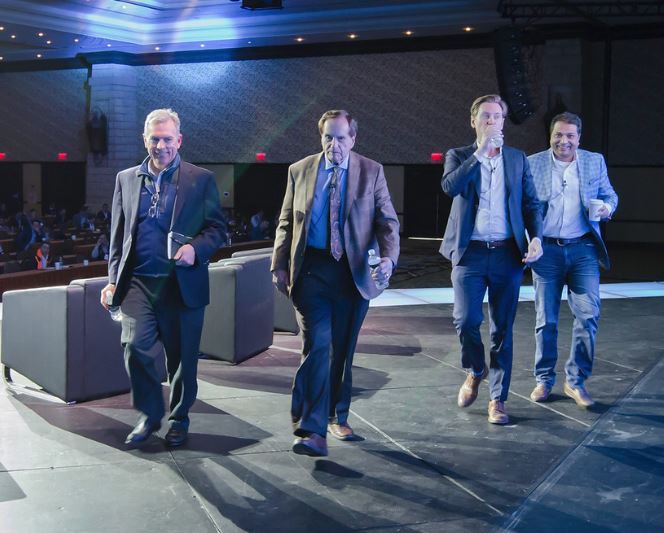
Leaving the stage after their panel (L to R): John Larkin, Stifel, Moderator; Don Daseke, CEO and Chairman, Daseke Inc., Eric Fuller, CEO, U.S. Xpress; Shaleen Devgun, Executive Vice President and CIO, Schneider. Photo: Truckstopimages
At a two-day conference in which rapid technology development and what’s to come was the focus of so many presentations, Eric Fuller of U.S. Xpress (NYSE: USX) provided a reality check.
On a panel earlier this week at MarketWaves18 near Dallas entitled “Enterprise Truckload Carriers Speak Out,” Fuller, the CEO of USX, said his company and other large carriers had adopted great amounts of new technology. But they aren’t the whole industry. A lot of other carriers, Fuller said, “are operating on a 1980’s platform.”
It was a reminder that while the conference may have been filled with cutting-edge executives, there were a lot of people not attending such gatherings and they are operating the same way they did many years ago.
But even for them, Fuller said, “over the next five to 10 years, that is not going to be an option.”
With so much focus at MarketWaves on technology and markets, it was an unusual conference in that driver recruitment and retention was not front and center the way it is at so many other events. But Fuller said technology is one of the key tools in retention.
The integrated technology that is being developed, Fuller said, doesn’t just have a “driver piece” and an “equipment piece.” Rather, he said, it’s a unified system that “takes all the friction out of the process.” And when those systems are working together, “it reduces friction and makes the job that much easier,” he said.
Shaleen Devgun, the executive vice president and CIO of truckload carrier Schneider (NYSE: SNDR) , agreed with Fuller when he said: “technology adoption has been limited.” He provided some numbers that were sweeping in their enormity: with more than 100,000 separate assets made up of tractors, trailers, drivers and other equipment, the possible combinations it could employ to get the job done runs in excess of 300 trillion.
“We need to bring it to our platform, which can digest it in real time,” he said, “and then push the intelligence to the right actor in the system.” That “actor” could be a customer service representative that is making the decision whether Schneider is going to accept a load.
Platforms will need to be equipped with machine learning and artificial intelligence to provide the best information to those “actors,” Devgun said. “Just bringing demand capacity across from each other is not the solution,” he said. The demand that is out there needs to be aggregated, but “somebody needs to play cupid” to put that demand with a buyer. And that cupid will be machine learning and AI, working through platforms that companies will use. “We’re seeing huge opportunities,” Devgun said.
Don Daseke, chairman of the flatbed aggregator that bears his name (NYSE: DSKE), noted that not all companies are in strong need of the type of aggregation and matching tool that Devgun talked about. His business is about 95% contract, “so we’re not really in the spot market,” he said. “We don’t use dynamic pricing.”











